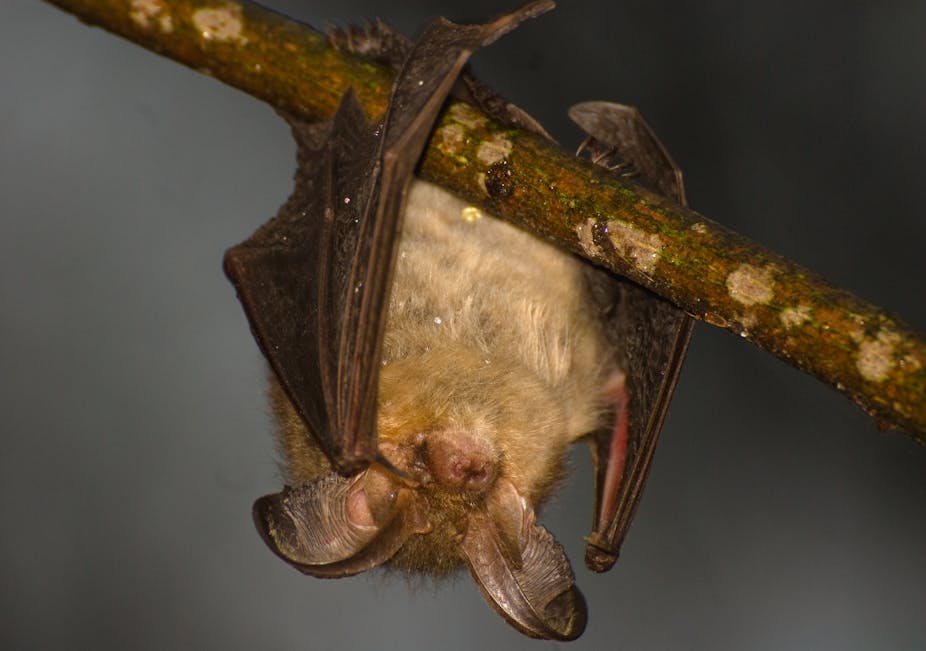Many bat species suffered severe population declines in the UK and elsewhere during the 20th century mainly due to their habitats being fragmented, damaged and destroyed, particularly in woodland areas. Though many species have stabilised or even increased slightly in the past couple of decades, numbers are still much lower than they were in the early 1900s.
The woodland destruction has made it harder for many bats to hunt and now they are also having to deal with other emerging threats such as wind turbines, artificial lighting and in North America, a disease known as white nose syndrome.
One of the difficulties for many bats is that they don’t necessarily like to feed where they roost. This is because they need very different things from each environment. Bats can roost in small places such as a tree crevice or an attic in a house, the main requirement being that they provide a stable micro-climate with optimum humidity and little variation in temperature.
But they need much bigger spaces to get enough food to keep their fast metabolisms functioning – flight requires lots of energy. Good foraging areas don’t need that stable micro-climate, but do need to provide lots of invertebrate prey such as moths and midges, plus a conducive hunting environment – areas without much vegetation are little use to species like the brown-eared bat, for instance, since they glean their food from it.
Winging it
You might think that being able to fly makes bats highly mobile animals that would find commuting to good hunting ground easy, but it’s not that simple. The mobility of bats very much depends on the shape of their wings. Species with long narrow wings such as noctules are usually well adapted to fly fast across open spaces, while others such as the common pipistrelle forage in moderately cluttered areas such as woodland edges. It can also commute long distances and catches its insect prey in the air.

Bats with shorter wider wings, such as the brown long-eared bat, are better suited to being highly manoeuvrable. This comes in very handy for getting hold of your dinner off vegetation in a cluttered woodland, but not so much when it comes to getting from habitat patch to hunting ground.
Roosting preferences also play a role in how species respond to environmental changes. While species like the brown long-eared bat are quite fussy about their requirements and only roost in or near trees, the likes of the common pipistrelle quite happily use human-made structures such as houses or bridges as their homes. More adaptable species are more comfortable with changes to their environment – most bats are not.
The upshot is that some bat species find the prospect of commuting long distances more severe than others. Slow and highly manoeuvrable fliers like the brown-eared bat don’t travel long distances to their foraging sites and are often reluctant to fly across open spaces. So they are very sensitive to woodlands being destroyed and fragmented.
Even species like the highly mobile common pipistrelle suffer from insensitive human development. It is less affected by deforestation, but still influenced by both the quality of the woodlands in which it forages and what is in their surroundings too. Landscapes which include tree lines, rivers and grasslands make it easier for these bats to commute than intensively farmed areas with nothing more than crops.

Help vs hindrance
We humans are making efforts to restore woodlands, having recognised how much bats depend on them – not to mention many other species, including ourselves. One promising mechanism for reversing or at least slowing down the damage is woodland creation and management schemes. These typically involve governments providing financial incentives for farmers to increase the amount and quality of woodland on their land. They are most common in certain European countries and Australia – for example in the UK, they have helped increased woodland cover from a low of 5% in 1900 to 13% today.
Unfortunately newly planted woodland areas are often of limited value for biodiversity. They tend to benefit highly mobile species, but not the fussier woodland specialists, since they don’t have the sort of good-quality undergrowth that develops over time in wooded areas. This means for example that they are not very attractive to moths, which are the preferred food for many bat species, including the brown long-eared bat, compounding its restricted mobility.

How to get around this problem? We should be using our knowledge of bat ecology to inform these interventions. We need to include efforts to increase undergrowth, for example, and recognise that most bat species like big old trees. Even for more flexible species, we also need to increase habitat connectivity by creating wooded corridors between woodland areas.
The same thing applies on a smaller scale to the likes of beetles and voles, and even lichens and mosses. They depend on high-quality local habitat too, as well as connections between wooded areas. Get these actions right and we will be far more successful at helping bats and other species. Get them wrong and our efforts to protect biodiversity and maintain the populations of bats and other creatures will not make much difference.

